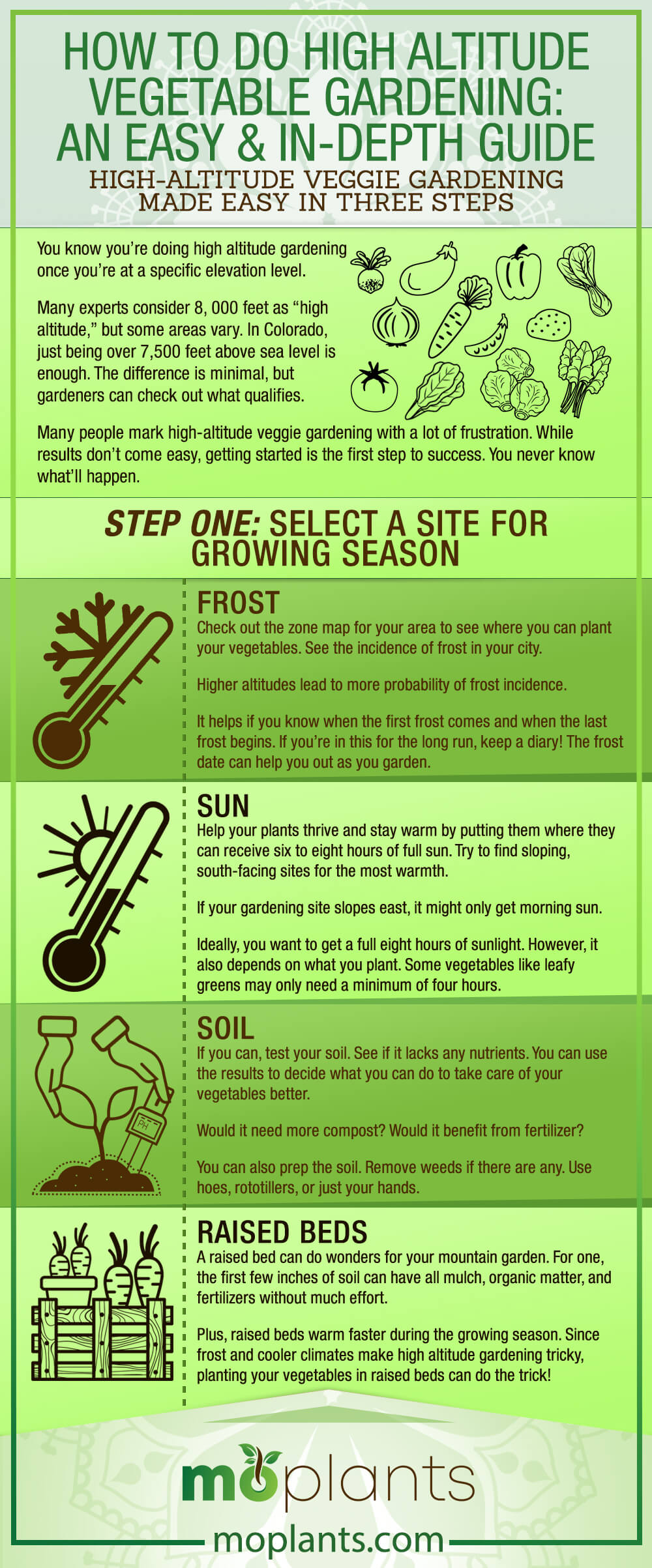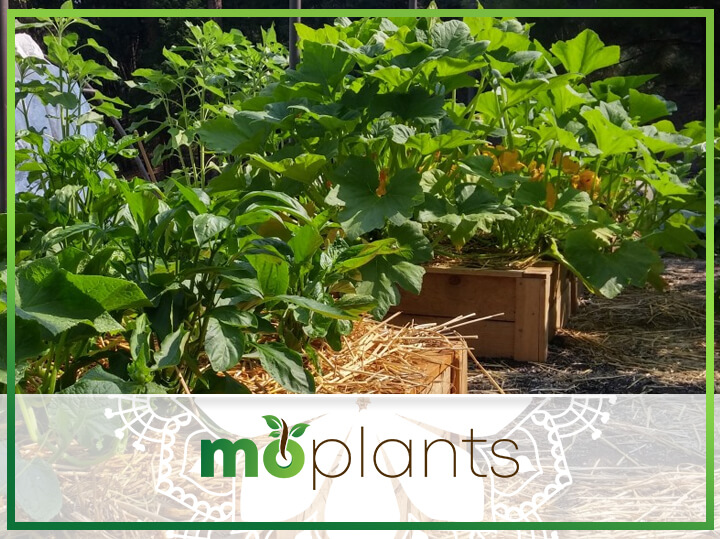If you’re looking to eliminate all frustration out of high altitude vegetable gardening, this is the guide for you.
Failure and frustration come with this gardening method, but you don’t need to let failure teach you all you need to know.
With enough knowledge and caution in hand, you can succeed with high altitude vegetable gardening.
All you have to do is work with what you’ve got! This article guides you through every step. Read on below!
What You’ll Need:
- Your choice of early-season vegetables or plants’ seeds
- Biodegradable pots
- Gardening tools (hoes, trowels, etc)
- Organic mulch (organic material such as wood chips, bark, leaves, for example)
- Inorganic mulch (landscape fabric, black plastic, and other geotextiles)
- Frames, sheets, or row covers for protecting the plants
High-Altitude Veggie Gardening Made Easy in Three Steps
You know you’re doing high altitude gardening once you’re at a specific elevation level.
Many experts consider 8, 000 feet as “high altitude,” but some areas vary. In Colorado, just being over 7,500 feet above sea level is enough. The difference is minimal, but gardeners can check out what qualifies.
Many people mark high-altitude veggie gardening with a lot of frustration. While results don’t come easy, getting started is the first step to success. You never know what’ll happen.
Follow the three steps below to get a headstart on your high-altitude vegetable garden!
Step One: Select a Site for Growing Season
Frost
Check out the zone map for your area to see where you can plant your vegetables. See the incidence of frost in your city.
Higher altitudes lead to more probability of frost incidence.
It helps if you know when the first frost comes and when the last frost begins. If you’re in this for the long run, keep a diary! The frost date can help you out as you garden.
Sun
Help your plants thrive and stay warm by putting them where they can receive six to eight hours of full sun. Try to find sloping, south-facing sites for the most warmth.
If your gardening site slopes east, it might only get morning sun.
Ideally, you want to get a full eight hours of sunlight. However, it also depends on what you plant. Some vegetables like leafy greens may only need a minimum of four hours.
If a vegetable garden is full of leafy greens, maybe a site that slopes east isn’t a bad idea.
You can also consider microclimates. Microclimates are atmospheric conditions that limit themselves to a specific area.
Microclimates tend to differ from the climate zone of the overall area. For example, a nearby body of water may cool a place down.
Planting near buildings, using fences, and stonescaping can help retain more heat for your vegetables.
You can also check if there are specifications for your area – shady spots, more wind, and other considerations.
Soil
If you can, test your soil. See if it lacks any nutrients. You can use the results to decide what you can do to take care of your vegetables better.
Would it need more compost? Would it benefit from fertilizer?
If you live in Colorado, the Colorado State University has soil testing kits available. You can avail yourself of veggie garden suggestions so you can improve your plants’ state!
You can also prep the soil. Remove weeds if there are any. Use hoes, rototillers, or just your hands.
Put compost to enrich the nutrients in the soil.
Raised Beds
A raised bed can do wonders for your mountain garden. For one, the first few inches of soil can have all mulch, organic matter, and fertilizers without much effort.
Plus, raised beds warm faster during the growing season. Since frost and cooler climates make high altitude gardening tricky, planting your vegetables in raised beds can do the trick!
Soil temperature rises, and you end up with healthier plants.
Another bonus is that bugs and pests don’t have much leverage on raised beds. They can’t climb up that easily!
Of course, raised beds are optional. They’re not a necessity for your garden. However, if you have a shorter growing season, it’s very beneficial for your vegetables.
Infographic

Step Two: Select Vegetables Thriving in Cool Climates
Now that you’ve got the right location, it’s time to pick out the right plants. You want them to thrive in their conditions no matter what.
Growing seasons are much shorter in the mountains. Once you’re on a high elevation, the higher you are, the shorter the growing season is.
While short growing seasons may sound like bad news for your plants, don’t lose hope.
What Plants Can You Pick?
Pick plants for your garden based on their days-to-harvest. Make the most out of a short growing season.
However, it won’t always work. Your plants’ days to maturity may be longer depending on relative conditions. Be alert for all weather conditions and adjust as much as you can!
What’s the best solution? Choose plants or vegetables that are hardy and have frost tolerance. They should thrive during the winter season. Some examples include:
- Painted mountain corn
- Sweet corn
- Brussels sprouts
- Spinach
- Garlic
- Turnips
- Kale
- Cabbage
Some semi-hardy plants for your vegetable garden are:
- Beets
- Cauliflower
- Parsley
- Lettuce
- Celery
- Winter squash
- Summer squash
You can also include perennials, like geraniums, asters, and spiderworts. They can withstand the growing season!
Purple pigment vegetables withstand rotting more. You can keep an eye out for them, too! As a general rule, early-season greens and root vegetables work well in high altitudes.
Start seeds indoors and transplant them after. You need pots to store them in before transplanting. To avoid killing your plants when you transplant them, put them in biodegradable pots.
It’s easy to transplant growing vegetables after that! Who knows? They might turn into bumper crops.
If you’re at a lower elevation, you may be able to cultivate a wider variety of plants for your garden. Add them on as you see fit.
Step Three: Give Your Plants Adequate Care
Water
Water your high elevation garden generously. Depending on your vegetable gardens’ varieties, you may need to water once or twice a day.
Check if two to four inches of soil is dry now and then so you can adjust water use. The only reason to skip out on watering is if it rains.
Remember, many challenges come with high altitudes. A strict watering schedule can help protect plants!
Nutrients
We highly recommend getting a soil test for the right amount of nutrients for your soil.
Get organic fertilizer. You want your seeds to establish deep roots, grow with vigor, and have the best odor and flavor compounds.
Add organic mulch to balance out the nutrients. When you grow plants in high country and mountain towns, you can expect loose soil that doesn’t have the proper nutrients.
This lack of nutrients is why fertilizers and mulch are vital to make sure your seeds grow successfully!
Shelter
Keep your seeds and crops on the mountains frost-free. While frost-tolerant plants can withstand a lot of the cold, it’s still best to keep your plants safe. Most of these plants grow in warm weather.
So, how do you protect them?
Covering them with sheets or even plastic can suffice. You leave them on overnight. Drape coverings loosely so you can still allow for air circulation.
You can also use hoop tunnels with plastic or fabric strung into them.
Expose plants to sunlight the next day when the temperature rises with the sun. You want them to get as much sunlight as possible in the high country.
You can use cold frames to create microclimates where your plants can thrive, no matter the season.
Some gardening tips: you can also use cold frames for your seeds! If you can’t bring seeds indoors, this is a feasible alternative.
You’re all set! Take care of your garden and make sure you provide adequate care.
Tips and Tricks for High Altitude Vegetable Gardening
Ready for some more gardening tips? Let’s see how else you can succeed with your gardening!
Tip #1: Patience is Everything
We’ll keep it real: how your crops fare will vary depending on your conditions, but don’t lose hope.
Sometimes, there are no other ways to go about gardening other than trial and error – plus a whole lot of patience. Keep this in mind as you track your results.
Tip #2: Keep a Diary
Attempting gardening on mountains is no easy feat.
Record every plant you use, the conditions, and any challenges you come across. When the growing season comes and goes, you can look back at what you did the last year you attempted gardening.
Did you have the worst hail storms? Did some crops survive, but some failed at the first sign of frost?
It can be fruitful. You can secure better success after everything.
Tip #3: Let a Local Community Help
Ask around! Situations vary from place to place — from Colorado to New Mexico.
A local farmer will have more insight than any book or experience can give you. Ask fellow gardeners about the last frost date. Inquire about how they handle plants and what their trusted methods are.
Tip #4 Use Mulch
We haven’t stressed this enough. Mulch has many benefits for your garden!
The state of soil in the mountains varies. For the soil to get many nutrients and retain water as much as possible, you can use mulch. Water and air circulation improve!
Plus, you get to keep weeds down.
It also keeps the soil moisturized. When you have to water crops daily, gardening can get tiring. Mulch can reduce your watering days.
Conclusion
High altitude vegetable gardening is tricky, but it’s one of the best experiences you can pull off! Follow as much as you can with this guide to improve your chances of plants surviving.
We hope you enjoyed this article! Let us know how your first high altitude vegetable gardening goes. Do you have any opinions, comments, or experiences to share? Say them in the comments!

